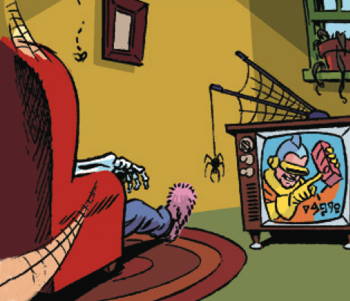November 2019
November 20, 2019
Anti-Eating Face Mask

Patent No. 4,344,424, granted to Lucy L. Barmby of Sacramento, California in 1982. From the patent description:
It goes into more detail about who the invention might benefit:
I'm imagining a husband preparing to go to work and strapping the anti-eating face mask on his wife before he leaves.
But couldn't the wearer just lift the mask off? Nope. It's locked on, though "under emergency conditions, the strap may be cut and the face mask of the invention removed."

Edmonton Journal - Oct 8, 2006
The invention reminds me of the Scold's Bridle, aka 'muzzle for ladies,' that some women were forced to wear back in olden times.
Posted By: Alex - Wed Nov 20, 2019 -
Comments (5)
Category: Inventions, Patents, Dieting and Weight Loss
Mystery Illustration 89

What occasion brings all these young lads together?
The answer is here.
Or after the jump.
More in extended >>
Posted By: Paul - Wed Nov 20, 2019 -
Comments (0)
Category: Ceremonies, 1950s
November 19, 2019
The Pedestrian Horn
We've posted before about Los Angeles auto dealer Hilton Tupman who, back in 1948, invented a "pedestrian horn" that he used to honk at motorists.
Great ideas like that tend to get recycled. So, recently artist Yosef Lerner unveiled a pedestrian horn for the 21st century. His intent was satirical. He wanted to make the point that honking at people can be obnoxious, whether you're on foot or in a car. But for a while he was actually offering his pedestrian horn for sale on his website, at $699 each. He decided to stop selling them because (as he told Gizmodo) he didn't want "to contribute to any more noise in this city!”

For the record, Tupman didn't invent the idea of a pedestrian horn. Actress Eleanor Whitney had rigged one up in 1932.

Chambersburg Public Opinion - Apr 9, 1932
And as early as 1927, there's a report in the NY Times about an unnamed man from Southampton, England who had attached a "miniature but noisy motorhorn" to his walking stick and then "sounded warning blasts to the more fortunate ones in automobiles when he was about to cross."

New York Times - Oct 7, 1927
Posted By: Alex - Tue Nov 19, 2019 -
Comments (1)
Category: Motor Vehicles, Cars, Cacophony, Dissonance, White Noise and Other Sonic Assaults
The Philco Safari
More info.
More pics.
Posted By: Paul - Tue Nov 19, 2019 -
Comments (5)
Category: Technology, Television, 1950s
November 18, 2019
Weirdo the Cat-Killing Superchicken
Weirdo was a giant among chickens. He weighed a colossal twenty-three pounds — about four times the size of an average rooster. Throughout much of the 1970s and 80s, he was listed in the Guinness Book of Records as the heaviest chicken in the world. He was said to have the strength and stamina of an ostrich.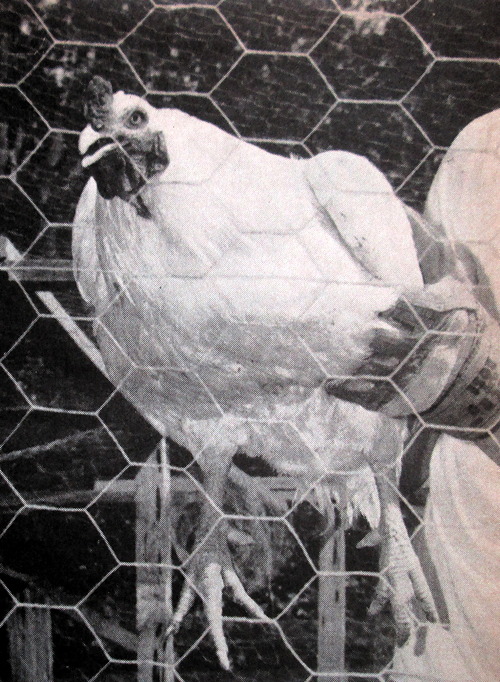
However, Weirdo had a temper and ferocity that matched his size. His violent exploits were legendary. He killed two cats and pecked out the eye of a dog. He routinely tore bits of metal off his feed bucket, demolishing feeders at a rate of one per month. When an ungloved visitor made the mistake of trying to touch him, he removed their fingertip. He shattered the lens of a camera. And, in his crowning achievement, he managed to rip through a wire fence and attacked and killed one of his own sons, an eighteen-pound rooster.
Just as unusual as Weirdo himself was the story of how he came to exist. He was the result of a seven-year chicken-breeding program conducted by a teenage boy, Grant Sullens, of West Point, California. Sullens had decided that he wanted to create a breed of "superchickens," and he actually achieved his goal, succeeding where highly paid poultry researchers had failed.
More in extended >>
Posted By: Alex - Mon Nov 18, 2019 -
Comments (4)
Category: Animals, Farming, 1970s
Follies of the Madmen #453
The wealthy always employ midgets to help them dress. Seriously, what size is that person standing on the chair? Maybe the gal in undergarments is a giant?
Source.
Posted By: Paul - Mon Nov 18, 2019 -
Comments (0)
Category: Ambiguity, Uncertainty and Deliberate Obscurity, Business, Advertising, Confusion, Misunderstanding, and Incomprehension, Excess, Overkill, Hyperbole and Too Much Is Not Enough, Surrealism, Underwear, 1940s
November 17, 2019
When the Cook Can’t Look
A cookbook for the blind, written by Ralph Read, and published in 1981.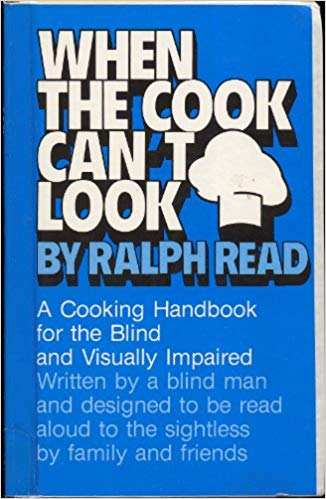
A sample of some of his tips and techniques, from a review in the Austin American-Statesman (Sep 22, 1980):
You don’t need to alphabetize bags of things, he says, because you can just pinch them. Split peas do not feel like elbow macaroni.
Tactile memory is very important, for things like knowing which end of a milk carton has the spout. Spices don’t need labeling because you can smell them. Smell and hearing are important factors in cooking without sight. They tell you when things are almost done.
He generally cooks slowly to help “prevent things from getting away from me.” Read has no special gadgets for cooking, though he says friends have shown him catalogs with specialty items for the blind. “Ninety-nine percent of that gadgetry is useless — though I’m interested in the fact that Amana has a blind consultant working with them in Dallas to help develop a microwave oven for the blind.”
There are some definite “don’ts,” Read says, such as not using dangerous items such as an electric beater or broiler. You can get the same desired results without unnecessary risk by using a hand beater or pan-broiling a steak.
You can read the entire book at archive.org.
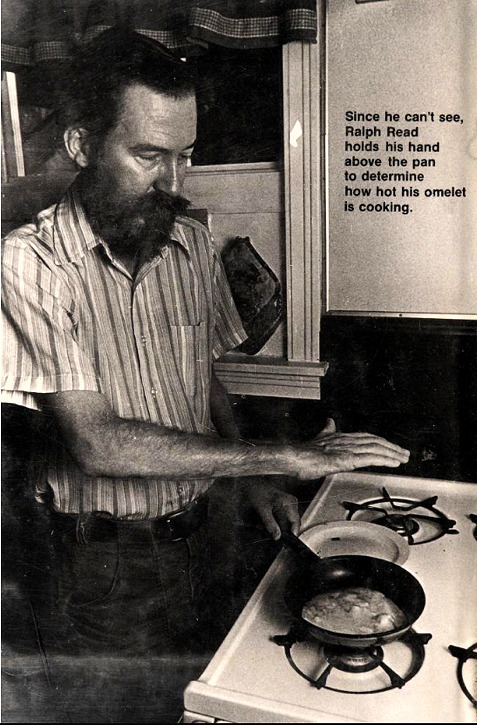

Posted By: Alex - Sun Nov 17, 2019 -
Comments (3)
Category: Food, Cookbooks, Books, Differently Abled, Handicapped, Challenged, and Otherwise Atypical
De Kermisklanten
(Foreign) Wikipedia page.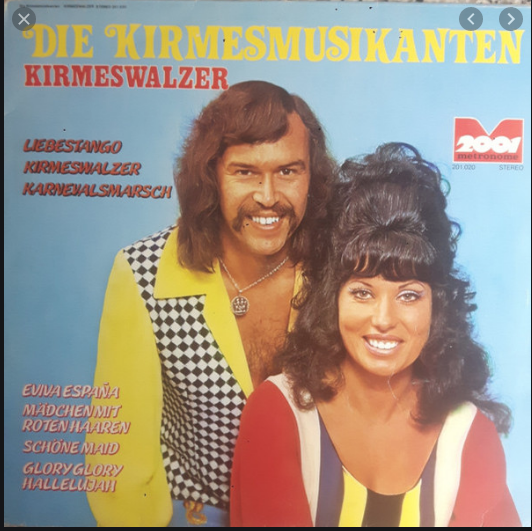
Posted By: Paul - Sun Nov 17, 2019 -
Comments (1)
Category: Foreign Customs, Cacophony, Dissonance, White Noise and Other Sonic Assaults
November 16, 2019
Glue Perfume
Sold by Demeter Fragrances, which specializes in weird perfumes.Some of their other scents include Condensed Milk, Dirt, Earthworm, Fireplace, Funeral Home, Laundromat, Pizza, Play-Doh, Sawdust, and Stable.

Posted By: Alex - Sat Nov 16, 2019 -
Comments (4)
Category: Perfume and Cologne and Other Scents
Right and Wrong in Fashion
"Street Fashion Critic:" good excuse to ogle women.
Posted By: Paul - Sat Nov 16, 2019 -
Comments (3)
Category: Experts and Authority Figures, Fashion, 1940s
| Get WU Posts by Email | |
|---|---|

| Who We Are |
|---|
| Alex Boese Alex is the creator and curator of the Museum of Hoaxes. He's also the author of various weird, non-fiction books such as Elephants on Acid. Paul Di Filippo Paul has been paid to put weird ideas into fictional form for over thirty years, in his career as a noted science fiction writer. He has recently begun blogging on many curious topics with three fellow writers at The Inferior 4+1. Chuck Shepherd Chuck is the purveyor of News of the Weird, the syndicated column which for decades has set the gold-standard for reporting on oddities and the bizarre. Our banner was drawn by the legendary underground cartoonist Rick Altergott. Contact Us |
